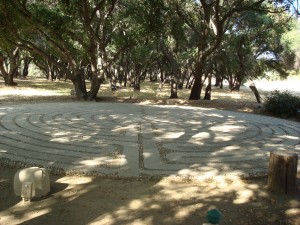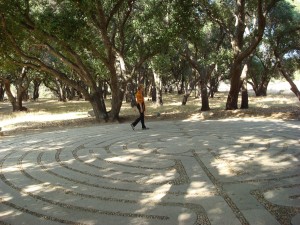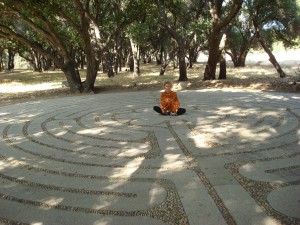Wednesday, Oct 26, 2011 The Labyrinth at Rancho La Puerta
 I returned to the studio this week after a transformative experience at Rancho La Puerta. I want to share everything about my week in Mexico, but there’s too much to tell all at once, so today I will focus on the Labyrinth. Rather than try to explain it myself, I will provide this description from the Rancho:
I returned to the studio this week after a transformative experience at Rancho La Puerta. I want to share everything about my week in Mexico, but there’s too much to tell all at once, so today I will focus on the Labyrinth. Rather than try to explain it myself, I will provide this description from the Rancho:
You are about to discover a long-dormant mystical tradition that insists on being reborn in modern society. Welcome…
Evolved from the spiral forms of nature, labyrinths have been known to the human race for over four thousand years. The Cretan labyrinth, Hopi medicine wheel, Jewish Kabbala (Tree of Life) and Tibetan sand paintings… all share the labyrinth motif and theme of transformation… either through meditation or a participant’s actual walk along the path.
 Not a maze—which confuses the participant with game-like devices such as cul-de-sacs, false leads, high walls, and other elements of challenge—the labyrinth seeks to quiet our mind and lead us to peace and inner knowing.
Not a maze—which confuses the participant with game-like devices such as cul-de-sacs, false leads, high walls, and other elements of challenge—the labyrinth seeks to quiet our mind and lead us to peace and inner knowing.
Rancho La Puerta’s labyrinth is an archetypal and non-denominational mind/body/spirit experience, and is a replica of the famous floor labyrinth laid in Chartres Cathedral sometime between 1194 and 1220.
The path is a classical eleven-circuit design, a metaphor for our journey through life. One path takes you to the center and back out again, leading you through many turns. The six-petaled center is known as the rosette. In some traditions, each petal of the central rosette symbolizes one of the six stages of planetary evolution. Standing in the center, the first to the left is mineral, the second (moving clockwise) is vegetable, then animal, human, angelic and divine. Ten labyrs—the hourglass—are symbols of women’s creativity and power. Each two-thirds circle along the outer edge is a lunation that tracks moon cycles and may have been a way of determining religious feasts in the Middle Ages. Your guide to the experience will further explain may of these fascinating references.
 May you find all you seek on your journey.
May you find all you seek on your journey.
Before you begin to walk our labyrinth… pause and take a deep breath.
Allow yourself to focus and slow down. Find your own pace. You may pass people or allow them to walk around you. The path is two-way. If you are going in and another person is going out, you will meet on the path. Do what feels natural.
As you walk, you may either choose to let all thought go and open yourself to the experience, or you may consider a question as you walk.
 The walk into the labyrinth is a time of releasing and letting go of the details of your life. The center is a place of meditation and receiving what is there for you to receive.
The walk into the labyrinth is a time of releasing and letting go of the details of your life. The center is a place of meditation and receiving what is there for you to receive.
As you leave the center and retrace the path that brought you in, focus on integrating the insights you have received.
Each experience in the labyrinth is different.
The best way to learn about the labyrinth is to walk it a few times with an open heart and open mind.
Adapted from “Walking a Sacred Path” by Dr. Lauren Artress
You don’t need a labyrinth to create this experience for yourself. Simply walking in a spiral pattern or along a well-known path can allow you to free your mind of worries and chatter. Questions may be answered and insights gained. At the very least, you will leave the experience with a feeling of peace. Try it for yourself.

